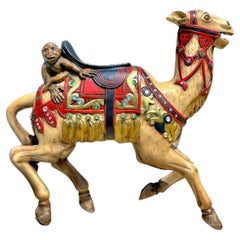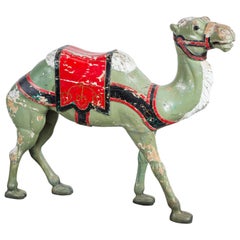Carousel Camel
Mid-20th Century Unknown American Craftsman Animal Sculptures
Wood
Recent Sales
Antique Early 1800s North American Carnival Art
Antique Late 19th Century American Folk Art Carnival Art
Wood
Early 20th Century American Carnival Art
Wood, Leather
Late 20th Century European Folk Art Carnival Art
Wood
People Also Browsed
Antique Late 19th Century Chinese Beds and Bed Frames
Lacquer, Wood
1920s Figurative Paintings
Canvas, Oil
Antique Late 19th Century Japanese Edo Lacquer
Bronze
Vintage 1930s American Art Deco Chandeliers and Pendants
Brass
Antique 15th Century and Earlier German Decorative Art
Other
20th Century Italian Figurative Sculptures
Marble, Bronze
Antique 19th Century Italian Baroque Rocking Chairs
Silver Leaf
Antique Late 19th Century French Belle Époque Table Lamps
Bronze, Ormolu
17th Century Baroque Figurative Paintings
Canvas, Oil
Vintage 1910s American Vases
Sterling Silver
Antique 19th Century French Napoleon III Vases
Bronze, Ormolu
21st Century and Contemporary French Baroque Natural Specimens
Coral, Quartz, Tourmaline, Bronze
Antique Mid-19th Century English Sheffield and Silverplate
Silver Plate
Vintage 1970s Italian Baroque Sterling Silver
Sterling Silver
Antique 19th Century English Victorian Game Tables
Mirror, Wood, Lacquer
Antique 18th Century English Other Historical Memorabilia
Mahogany
Finding the Right Carnival-art for You
The collection of original antique and vintage carnival art on 1stDibs includes paintings and posters that promoted traveling carnivals and circuses of years past as well as masks, sculptures and other works of folk art associated with widespread public celebrations that mark the start of harvest season or are rooted in religion.
The concept of “Carnival” is linked to an event that precedes Lent, the season of preparation before Easter for Christians (it may also have roots in Ancient Rome’s pagan Saturnalian festival), while the modern traveling carnival that we know — i.e., amusement fairs — existed during the 19th century in North America. The Chicago World’s Fair in 1893 was pivotal to these traveling amusement fairs.
Some of the most famous celebrations of Carnival around the world include Karneval in Germany, Carnival in Brazil and Mardi Gras in the United States. Carnival in Barbados is a traditional harvest festival. The bright colors, the caricatured masks and floats and the over-the-top nature of Carnival continue to enthrall millions across the globe.
Carnivals have always given way to impressive displays of creativity and folk art. Folk art is art created by people who are not classically trained for either utilitarian or decorative purposes. With respect to visual art in folk art, it refers to work that is reflective of a community’s culture and usually handmade by craftspeople working within a popular tradition.
Carnival art reflects the way different cultures celebrate or mark an important community event. Some examples of Carnival art include fabric dolls and marionettes that are used to tell stories and capture your imagination. Antique dolls make for striking collectibles positioned for display on any shelf in your home, while carnival masks make a bold statement as wall art. A collection of masks could create an elevated accent wall in a living room or dining room.
Browse 1stDibs to find unique antique and vintage carnival art for your space today.
Read More
A Giant Wedding Cake Has Us Looking at Portuguese Tiles in a New Light
At Waddesdon Manor, artist Joana Vasconcelos has installed a three-tiered patisserie inspired by the narrative tile work of her homeland. We take a look at the cake sculpture and how Portuguese tiles have been used in architecture from the 17th century to today.
Why Jules Chéret Was the King of the Modern Poster
The streets of fin-de-siècle Paris were set aglow with colorful poster ads, thanks to the printing techniques invented by Jules Chéret. Now, the Milwaukee Art Museum is celebrating this undersung talent in America's first solo show dedicated his exuberant works.
Why the American Flag Has Had So Many Different Star Patterns
Expert Jeff Bridgman explains the history and meaning behind the twinkling constellations that have graced Old Glory.
Peggy Guggenheim Loved Modernism, but She Also Collected Tribal Art
The iconoclastic style setter displayed African and Oceanic art, as well as works by indigenous peoples of the Americas, alongside pieces by such major modernists as Pablo Picasso and Jackson Pollock.
The 13-Star American Flag Had More Variations Than You’d Think
Perfect for July 4th weekend, a new show at Philadelphia's Museum of the American Revolution displays an array of antique red, white and blue flags.
Tramp Art, America’s Most Misunderstood Art Form, Is Trending in Interiors
Designers are beginning to see this enigmatic form of folk art in a whole new light.


